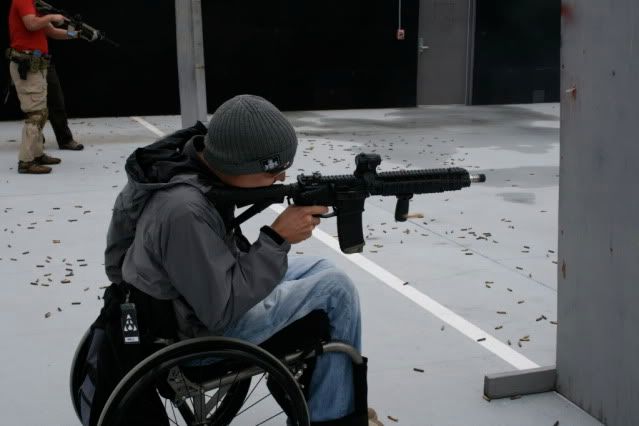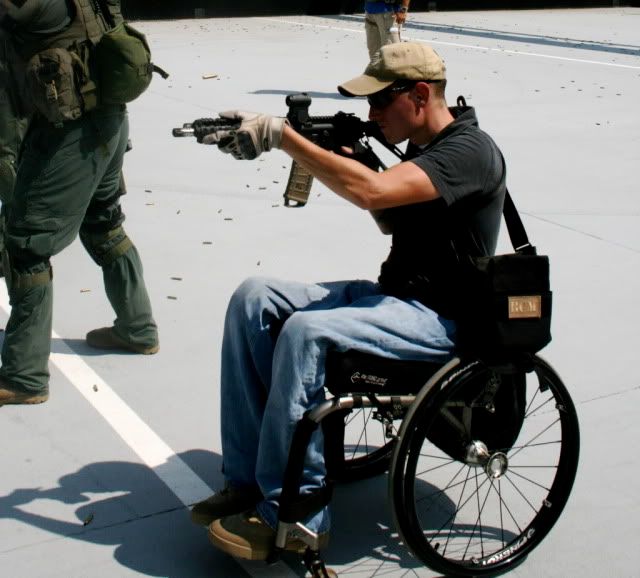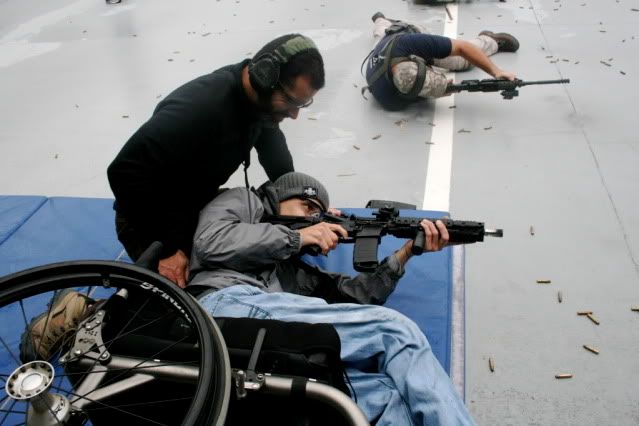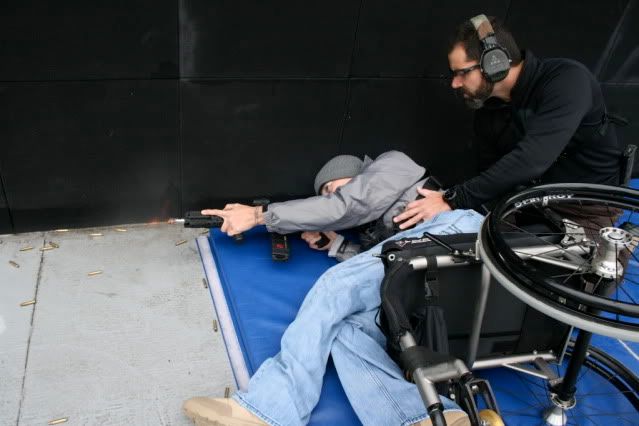Motivational Photo
Moderator: carlson1
-
Wysiwyg101
- Member
- Posts in topic: 1
- Posts: 124
- Joined: Wed Nov 17, 2010 10:22 pm
- Location: Plano, TX
Re: Motivational Photo
That's truly awesome. God Bless Our Troops.
Re: Motivational Photo
Here's another
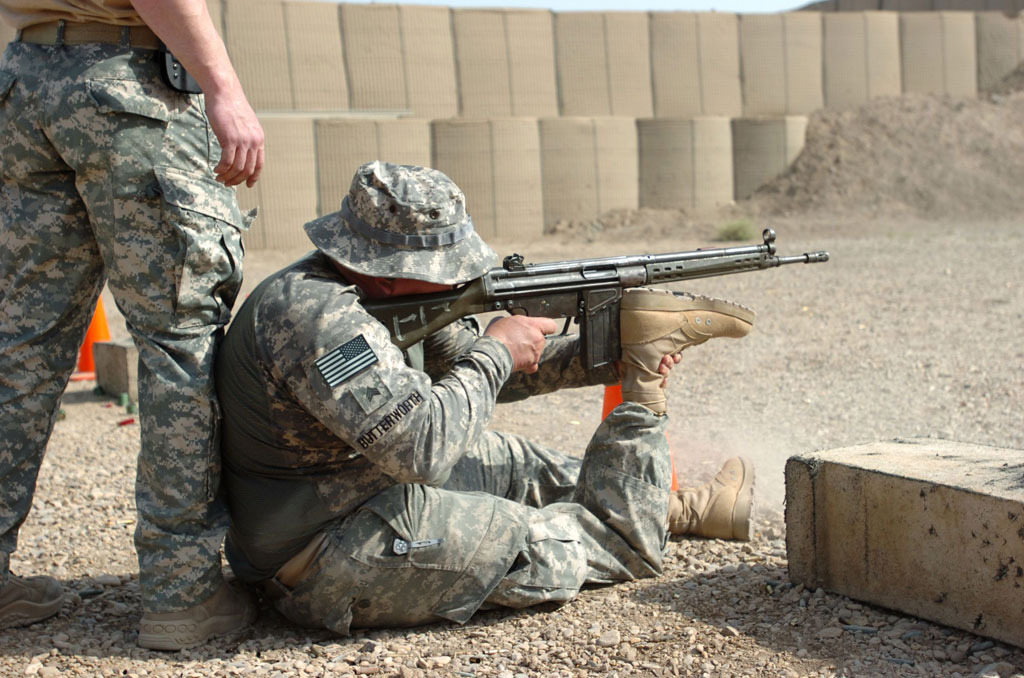
One of the finest things the military has finally done is to allow these "heros" to continue to serve, if they wish, rather than forced retirement. How can anyone not be so proud of them?

One of the finest things the military has finally done is to allow these "heros" to continue to serve, if they wish, rather than forced retirement. How can anyone not be so proud of them?
-
Jumping Frog
- Senior Member
- Posts in topic: 2
- Posts: 5488
- Joined: Wed Aug 25, 2010 9:13 am
- Location: Klein, TX (Houston NW suburb)
RE: The Mind is the Weapon, Everthing else is a tool
Along similar lines, here is another set of photos, with an AAR from this Marine, paralyzed in Iraq. His name is Paul, this is his story (original link - http://m4carbine.net/showthread.php?t=38540" onclick="window.open(this.href);return false; ) : I believe it is OK to quote this, as he explicitly gives permission.

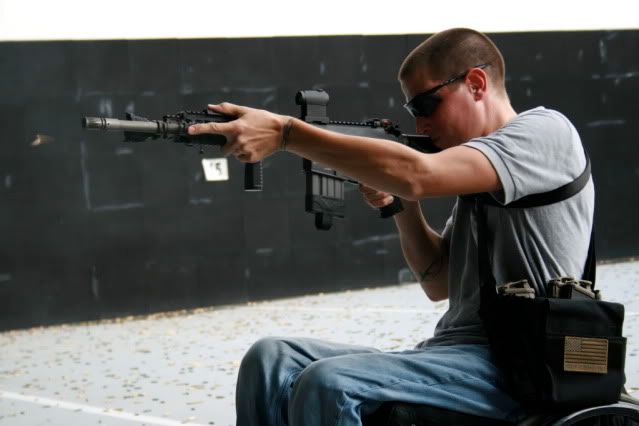


Lessons Learned In Combat
I originally wrote and posted this in the AAR for my recent carbine course on the Alumni Forum. But I think it would interest a lot of you here as well. Feel free to cross-post or share it where and how you see fit, as I want it to have as much of an impact as possible, and drive several key points home, on those who go in harms way, both on foreign soil (military and PMCs) and here at home (LEOs and civilian sheepdogs). Combat vets also feel free to post your own lessons learned in combat.
I'm Paul, the wounded Marine mentioned above in Jeff's AAR. I served as a Rifleman (MOS 0311- Get Some!!) during the initial invasion of Iraq some 6 1/2 years ago, and was severely wounded in one hell of a gunfight on April 12, 2003 in the city of Al Tarmiyah, a small suburb just northwest of Baghdad. I can now say with complete confidence that had I somehow been able to attend a TRICON class (or similar training class offered by another quality instructor) before I deployed to war, and had been able to learn all of the things taught by Jeff Gonzales in this carbine course I recently took here in Houston, I would NOT have been shot the way I was on that Sunday afternoon in Iraq. That's not to say I wouldn't have been blown to **** in an IED attack on my second deployment to Ramadi in 2004 (which is where my unit deployed next), but I would not have been shot that day and wouldn't be paralyzed from the waist down for the rest of my life.
For all of you Military and LEO guys out there (and guys and gals who are planning on enlisting in either of those fields sometime in the future), let that sink in a bit.
The reason for this belief of mine is fairly simple: When I was engaged in combat the day I was wounded, I made several critical mistakes resulting either from training scars or from simply not being trained how to do something in a certain manner (if at all). I know that training, tactics and procedures (TTPs) and SOPs have changed greatly over the past 6 years since I was wounded, but I guarantee that they are still lacking enough to where I would strongly advise anyone who is planning on going into harms way, either on foreign soil or here domestically in our own nation's cities, to reach out to the private sector for some enhanced weapons training. I believe that it could save lives, and could prevent a lot of men and women from being needlessly wounded (not all by any means, but quite a few such as myself).
Below is basically a summary of the events that (I strongly feel) led to my being paralyzed from the waist down. This is not an actual AAR of the entire firefight that my platoon was involved in, but rather a very small snippet of intel regarding just a few moments of combat involving just myself.On April 12, 2003, during the initial invasion of Iraq, my platoon was involved in a very well-executed ambush (the receiving end, unfortunately) in the Iraqi town of Al Tarmiyah- a small suburb that lies just northwest of Baghdad. The firefight that ensued would last an astounding 3 hours, which is almost unheard of today, and was basically my platoon (around 55 Marines) versus roughly 150+ Fedayeen Saddam Fighters, or so I was told several months afterwards. I was also later informed that we killed around 100 of the bastards that day. We suffered no KIAs, but had several WIAs (mostly from shrapnel from RPGs and hand grenades), with myself being the most severe injury of the day. It was because of engagements such as these that the enemy adapted and quickly learned not to go head-to-head with American forces... or suffer the consequences. Soon thereafter the insurgency began and they started using guerilla tactics, such as performing hit-and-run ambushes and placing IEDs on the country's roadways to inflict casualties on our side without the grave consequences of head-to-head engagements against us.
I won't discuss every detail of the attack and gun fight that followed the ambush, as it would be far too long, and this is already going to be a fairly long post.
After we were initially ambushed by RPGs and small arms fire in a T-shaped intersection from enemy fighters to both our north and south, while dismounted from our Amphibious Assault Vehicles (AAVs), my platoon split up and punched outward from the kill zone to take the fight to the enemy. The bad guys weren't expecting us to be so aggressive I don't think. But we were Marines, we were Infantrymen, and they had just {inappropriate language} us the **** off. We were already aggravated as hell that all of the Abrams tanks and Cobra gunships, which were always positioned just in front of us in our column of vehicles during the invasion (for obvious reasons), had been "stealing" our kills ever since we crossed the damn border a few weeks earlier, so needless to say we had literally been hoping that some bad guys would poke us with a stick and pick a fight with us.
About an hour and a half into the gun fight, I found myself in the backyard of a two-story residence. The 5 to 8 enemy fighters had fled the house after we fired a rocket into it. Several of them were using a mud/dirt/clay/whatever-the-**** guesthouse/storage building in the backyard as a make-shift bunker, and other fighters were outside of it. When I entered the backyard, my plan was to either find something to use as cover to get behind while I engaged the "bunker," or to make entry inside the house and shoot outside of a window or door... it was just hasty thinking on my part, and not an actual "plan." I just knew that I needed to find some cover to get behind so I could kill some of the bastards from relative safety.
As I rounded the corner of the house and entered the backyard, I immediately spotted an enemy fighter roughly 20 yards away at my 11 o'clock, low-crawling away from the bunker and dragging an AK47 with him. I stopped moving immediately and began engaging him. I fired at least 15 rounds at him, with most of the bullets impacting his body. Each time I scored a hit, his body let me know it by violently thrashing around. My adrenaline was pumping like crazy, which is why I continued to pummel him with rounds. I had never engaged an enemy that close before, and this was the very first time I could actually see my bullets impacting another human being's flesh, which is why I continued to fire my weapon over and over and over... it was just a shock to my psyche and I didn't know what else to do other than completely annihilate the threat in front of me. The only reason I quit firing is because another fighter stepped halfway out of the doorway to the "bunker" at my 1 o'clock and began firing wildly at me. I responded by shifting my fire over to him. I fired only about 5-7 rounds at him before my bolt locked to the rear on an empty magazine. I scored 1 hit somewhere on his torso, though I have no idea where. He fell backwards into the bunker's doorway and out of my sight.
I assumed that I had taken him out of the fight for good, either by killing him or wounding him badly. This would prove to be a huge error in judgement on my part.
Since my weapon was dry (a basic M16A2 service rifle with carrying handle using only the iron sights) and I needed to reload, I moved about 10 feet to my right. I wasn't behind cover, but I thought that if anyone else came out of the bunker doorway, that they wouldn't be able to see me. Besides, I was just going to quickly reload my rifle and get back into the fight, right? Wrong.
The Marine Corps had shown me once or twice in boot camp how to reload my M16 on the rifle range, but speed reloads and tactical reloads were never taught. There was one time during one training op before we deployed where a British Royal Marine, who was doing some training evaluation on my unit, showed us how to reload your rifle quickly and put the empty magazine in your cargo pocket so that you wouldn't waste time trying to put it back into your super-tight standard-issue mag pouches. Not to mention that you never want to re-insert an empty magazine into the same pouch(es) that you are going to instinctively index your fresh magazines from. But we never went over that or practiced it afterwards, so I never retained it and my body never memorized the motions of that technique. We actually never went over or practiced doing ANY kind of reloads; it was just something you were expected to know how to do: when your weapon runs dry, ya stick another magazine in it. That sounds simple, but I've discovered that it's a lot more complicated than that... especially when doing it under stress.
So, what did I do when it was time for me to reload my M16 on April 12, 2003? I pressed the magazine release, pulled the empty magazine out of the mag well, inserted the empty magazine back into one of my mag pouches (which took a couple extra seconds to do, especially considering I was inserting it into a pretty tight pouch that already had a magazine in it), indexed the fresh magazine from that pouch (which was positioned bullets-up in my pouch because way too many rounds would fall out of it when I tried carrying it upside down in the pouch... I'm guessing that's because the feed lips were worn, but I knew nothing about that back then and didn't even know that magazines were a disposable component), stuck it into the mag well until it seated and, finally after at least 8 seconds, pressed the bolt release button/paddle and sent another round flying into the chamber.
I was looking down the entire time I was doing this as well!
Well, when I was finally done reloading, and finally decided to look back in the direction of the enemy bunker just 20 yards away from me, that very same enemy fighter who I'd just ******* shot and assumed that I had put down for good, was aiming directly at me with his AK47 assault rifle.
While I had been performing my nasty-ass, slow-as-**** reload, and looking down at my gear and weapon as I was performing that abortion of a reload, he had gotten back up to his feet, moved out the doorway in order to search for the ******* American who greased his comrade and just shot him too, and moved down the wall of the bunker until he saw me standing there... performing my nasty, slow-**** reload, while staring down at my weapon and gear. He was now standing at my 11 o'clock, since I had moved to my right a little before reloading.
I had basically allowed... no, invited the **** to get the drop on me.
As soon as I finally looked up from reloading my weapon and saw him standing a mere 15 yards in front of me (at 11 o'clock) and aiming at me with his AK47, I began to raise my rifle and attempt to put him down for good this time. It is also worth noting that I was standing in a bladed stance as well, exposing my unprotected left side of my chest to the enemy, which was even more exposed since he was standing at my 11 o'clock as well. The Marine Corps never taught us to square up to the target and make the most use and take the most advantage of our ballistic SAPI plates. The only "standing" position that I knew of was the one taught to me by my Primary Marksmanship Instructor back in boot camp, which of course is only worth a **** on the flat range back home when qualifying with the rifle (just FYI, I was a "double-award" Expert marksman as well, which means jack **** in combat)... NOT for use in combat when wearing body armor meant to protect your vital organs (and spinal cord).
An additional mistake was having my rifle in roughly the "Low Ready" position as well, instead of keeping it pointed downrange the entire time I was reloading. So once I sent the bolt flying home and chambered another round, I had to raise my rifle instead of my rifle already being raised and at the "Ready," pointing downrange and ready to rock. However, I was wielding an M16A2 with a 20" barrel, so I guess that one could argue that it's a lot harder to keep that heavy rifle pointed downrange with one hand/arm. I'm not really sure if that's a valid argument or not, as I probably could've just "tucked" the butt stock under my armpit to aid in keeping the barrel pointed downrange during the reload.
-Just call me Bob . . . Texas Firearms Coalition, NRA Life member, TSRA Life member, and OFCC Patron member
This froggie ain't boiling! Shall not be infringed! Μολών Λαβέ
This froggie ain't boiling! Shall not be infringed! Μολών Λαβέ
-
Jumping Frog
- Senior Member
- Posts in topic: 2
- Posts: 5488
- Joined: Wed Aug 25, 2010 9:13 am
- Location: Klein, TX (Houston NW suburb)
Re: The Mind is the Weapon, Everthing else is a tool
So I began to raise my rifle to kill the enemy fighter, but I was too late. The last thing I saw was a bright muzzle flash from his AK47 as it fired a short burst of 7.62mm projectiles at me. One of those bullets impacted me just under my left armpit, in the exposed area that isn't protected by ballistic plates, and tumbled downward through my body. After shredding my spleen (which had to be removed), puncturing and collapsing my left lung, lacerating my stomach and left kidney, severing my aorta vein, and blowing out a large chunk of my vertebrae, the bullet completely severed my spinal cord at the T12/L1 level, which instantly and completely and permanently paralyzed me from the waist down.
There's a LOT more to this story of mine (obviously), but this small piece of it is all that's relevant in this particular forum.
The moral of this story is this:
Muscle memory can be a great thing when the tactics, techniques and procedures that you're muscles are memorizing are good and effective ones. But it works both ways, meaning that, for example, if you handle certain things in training in a relaxed "administrative" fashion, then you can bet your butt you will handle those things in combat the same way.
For a quick summary, here are the things that I did wrong in combat that led to my severe injury and disability:
-assuming I killed the bad guy with one shot to the torso area
-doing a slow reload
-retaining my empty magazine
-put an empty magazine in the general location where my fresh magazines were at
-staring down at my weapon while reloading
-not keeping my weapon pointed downrange during my reload
-standing bladed and not taking advantage of my ballistic plates
If you are in the military or a law enforcement officer, or even a civilian sheepdog, it would behoove you to get some training outside of your unit/department IMHO. Everything I learned in just the first day of my TRICON Combative Carbine 1 class could've helped to save my life in combat and prevent the injury that I needlessly sustained... I say that with complete and utter confidence. And take lots of notes and pictures at your class so that you can go back to your unit/department and spread the knowledge to your fellow brothers-in-arms. If you are a squad leader, you have an obligation to ensure that your young Marines/Soldiers can perform speed reloads quickly, know when and where not to retain a magazine during a reload, and how and when to perform a tactical reload, etc... Practice these things until they become second nature and fluid movements and part of that good ol' muscle memory.
When you attend good courses given by quality companies like Trident Concepts and EAG Tactical (among many others), these things are taught to you, and they are taught for a reason. These tactics, techniques and procedures are taught this way in order to prevent very preventable injuries like mine. So pay attention and learn in class so that you don't get schooled in the middle of a gunfight instead, like I did.
Also please note that I don't want to come off like I'm "blaming" the Corps for my injury. However, I strongly feel that the TTPs could be improved. There are some things that can truly only be learned through actual combat experience, but in my opinion and experience there is a lot of knowledge available out there that is simply going to waste and not being implemented in a unit's training and work-up, and should definitely be included as the "standard."
Semper Fi'!!
Paul
Train, Train, Train!! And never, ever give up!
-Just call me Bob . . . Texas Firearms Coalition, NRA Life member, TSRA Life member, and OFCC Patron member
This froggie ain't boiling! Shall not be infringed! Μολών Λαβέ
This froggie ain't boiling! Shall not be infringed! Μολών Λαβέ
-
Heartland Patriot
Re: Motivational Photo
The young man who described his firefight and injury is a very brave young man indeed. I admire his ability to analyze the events that led to his combat injury and to put out his story to hopefully help others to avoid those same incidents that led up to it. None of that withstanding, no one can ever talk trash to him, on "St. Crispin's day".
-
Mr.ViperBoa
- Senior Member
- Posts in topic: 1
- Posts: 293
- Joined: Wed Jan 12, 2011 9:29 pm
- Location: Bedford, Texas
Re: Motivational Photo
G26ster wrote:Here's another
One of the finest things the military has finally done is to allow these "heros" to continue to serve, if they wish, rather than forced retirement. How can anyone not be so proud of them?
